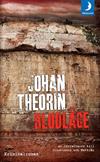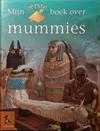
Minority Report
by Author unknown | Science Fiction & Fantasy | This book has not been rated.
ISBN: 140723093X Global Overview for this book
ISBN: 140723093X Global Overview for this book
1 journaler for this copy...
Have you ever picked up a book and wondered where it had been before, well welcome to the world of bookcrossing!
Bookcrossing is a wonderful place to share your love of reading with people all over the world and follow a book as it continues on its travels.
Please journal this book, describing where you found it, and then if you want to, what you thought of it. You can remain anonymous if you want to, though if you create a screen name you will be able to get notification each time someone else journals this book in the future.
When you have finished with it please release the book by leaving it somewhere where it will be found (please make a journal entry stating where you left it), and let it continue its journey.
Help keep its journey alive!Following this books travels can be very fun.
..............................................................................................
Bookcrossing is a wonderful place to share your love of reading with people all over the world and follow a book as it continues on its travels.
Please journal this book, describing where you found it, and then if you want to, what you thought of it. You can remain anonymous if you want to, though if you create a screen name you will be able to get notification each time someone else journals this book in the future.
When you have finished with it please release the book by leaving it somewhere where it will be found (please make a journal entry stating where you left it), and let it continue its journey.
Help keep its journey alive!Following this books travels can be very fun.
..............................................................................................
"The Minority Report" is a 1956 science fiction short story by Philip K. Dick, first published in Fantastic Universe. The story is about a future society where murders are prevented through the efforts of three mutants who can see the future. Paradoxes and alternate realities are created by the precognition of crimes when the chief of police intercepts a precognition that he is about to murder a man he has never met. The story also touches upon the dangers of a powerful post-war military during peacetime. Like many stories dealing with knowledge of future events, "The Minority Report" questions the existence of free will.
In 2002, the story was adapted into a film directed by Steven Spielberg.
Precrime
Founded thirty years prior to the story, Precrime is a system which punishes people with imprisonment for murders they would have committed, had they not been prevented. This method has replaced the traditional system of discovering a murder and its perpetrator(s) after the crime, then issuing punishment for a completed action. As one character says in the introduction to the story, "punishment was never much of a deterrent and could scarcely have afforded comfort to a victim already dead". Unlike the film adaptation, the story version of Precrime does not deal solely with cases of murder, but all crimes. As John Anderton (the initiator of Precrime) states, "Precrime has cut down felonies by 99.8%."
The system of predicting the future by reports is performed by three mutants known as "precogs", because of their precognitive abilities by which they can see up to two weeks into the future. The precogs sit in a room which is perpetually in half-darkness, constantly talking nonsense to themselves that is incoherent until it is analyzed by a computer and converted into predictions of the future. This information is assembled by the computer into the form of symbols before being transcribed onto conventional punch cards which are ejected into various coded slots: when cards are produced, they appear simultaneously at Precrime and the army general headquarters, in order to prevent corruption.
Precogs
Precogs are produced by identifying the talent within a "subject" and developing it in a government-operated training school — for example, one precog was initially diagnosed as "a hydrocephalic idiot" but the precog talent was found under layers of damaged brain tissue. The precogs are kept in rigid position by metal bands, clamps and wiring, which keep them attached to special high-backed chairs. Their physical needs are taken care of automatically and it is said that they have no spiritual needs. Their physical appearance is somewhat different from that of ordinary humans, with enlarged heads and wasted bodies. Precogs are deformed and retarded, "the talent absorbs everything"; "the esp-lobe shrivels the balance of the frontal area". They do not understand their predictions. Most of the data produced is useless for preventing murders and is passed to other agencies.
Majority and minority reports
Each of the three precogs generates its own report or prediction. The reports of all the precogs are analyzed by a computer and, if these reports differ from one another, the computer identifies the two reports with the greatest overlap and produces a majority report, taking this as the accurate prediction of the future. But the existence of majority reports implies the existence of a minority report. In the story, Precrime Police Commissioner John A. Anderton believes that the prediction that he will commit a murder has been generated as a majority report. He sets out to find the minority report, which would give him an alternate future.
However, as Anderton finds out, sometimes all three reports differ quite significantly, and there may be no majority report, even though two reports may have had enough in common for the computer to link them as such. In the storyline, all of the reports about Anderton differ because they predict events occurring sequentially, and thus each is a minority report. Anderton's situation is explained to be unique because he, as Police Commissioner, received notice of the precogs' predictions, allowing him to change his mind and invalidate earlier precog predictions.
Multiple time paths
The existence of three apparent minority reports suggests the possibility of three future time paths, all existing simultaneously, any of which an individual could choose to follow or be sent along following an enticement (as in Anderton's being told he was going to murder an unknown man). In this way, the time-paths overlap, and the future of one is able to affect the past of another. It is in this way that the story weaves a complicated web of crossing time paths and makes a linear journey for Anderton harder to identify. It is the theory of multiple-futures which allows the precogs of Precrime to be of benefit, because if only one time-path existed, the predictions of the precogs would be worthless, since no possibility would exist of altering the future. Precrime is based on the notion that once one unpleasant future pathway is identified, an alternative, better one can be created with the arrest of the intended perpetrator.
Film adaptation:
The 2002 film Minority Report directed by Steven Spielberg and with Tom Cruise as main actor, was based on the story.
Differences between short story and film
1. The story is set in New York City, while the film uses the backdrop of Washington, D.C., Baltimore and Northern Virginia.
2. In the story, John Anderton is a 50-year old balding, out-of-shape police officer who created Precrime, while in the movie Anderton is in his late 30s, handsome, drug addict, athletic, with a full head of hair who joined Precrime after his son's kidnapping. His wife in the short story is named Lisa, while his ex-wife in the film is named Lara.
3. The precogs were originally named Mike, Donna, and Jerry, and were deformed and intellectually disabled. In the adaptation, they are called Agatha, Dashiell, and Arthur — after crime writers Agatha Christie, Dashiell Hammett, and Arthur Conan Doyle — children of drug addicts whose mutations led them to dream of future murders, which are captured by machines. They are "deified" by the Precrime officers, and are implied to be intelligent (Agatha guides Anderton successfully through a crowded mall while being pursued by Precrime, and the trio are seen reading large piles of books at the end of the film). In the end of the movie they retire to a rural cottage where they continue their lives in freedom and peace.
4. In the short story, the precogs can see other crimes, not just murder. In the movie, the precogs can only see murders.
5. in the short story, Anderton's future victim is General Leopold Kaplan, who wants to discredit Precrime in order to get more financing for the military. At the end of the story, Anderton kills him to prevent the destruction of Precrime. In the movie, Anderton is supposed to kill someone named Leo Crow, but later finds out Crow is just part of a set up, to prevent Anderton from discovering a different murder that his superior, Lamar Burgess, committed years ago. At the end of the film, Anderton confronts Burgess, who commits suicide and sends Precrime into oblivion.
6. In the short story, Anderton seeks the precogs to hear their "minority reports". In the movie, Anderton kidnaps a precog in order to discover his own "minority report" and extract the information for a mysterious crime.
7. The short story ends with Anderton and Lisa essentially exiled to a space colony after Kaplan's murder. The movie finishes with John and Lara reunited after the conspiracy's resolution, expecting a second child.
In 2002, the story was adapted into a film directed by Steven Spielberg.
Precrime
Founded thirty years prior to the story, Precrime is a system which punishes people with imprisonment for murders they would have committed, had they not been prevented. This method has replaced the traditional system of discovering a murder and its perpetrator(s) after the crime, then issuing punishment for a completed action. As one character says in the introduction to the story, "punishment was never much of a deterrent and could scarcely have afforded comfort to a victim already dead". Unlike the film adaptation, the story version of Precrime does not deal solely with cases of murder, but all crimes. As John Anderton (the initiator of Precrime) states, "Precrime has cut down felonies by 99.8%."
The system of predicting the future by reports is performed by three mutants known as "precogs", because of their precognitive abilities by which they can see up to two weeks into the future. The precogs sit in a room which is perpetually in half-darkness, constantly talking nonsense to themselves that is incoherent until it is analyzed by a computer and converted into predictions of the future. This information is assembled by the computer into the form of symbols before being transcribed onto conventional punch cards which are ejected into various coded slots: when cards are produced, they appear simultaneously at Precrime and the army general headquarters, in order to prevent corruption.
Precogs
Precogs are produced by identifying the talent within a "subject" and developing it in a government-operated training school — for example, one precog was initially diagnosed as "a hydrocephalic idiot" but the precog talent was found under layers of damaged brain tissue. The precogs are kept in rigid position by metal bands, clamps and wiring, which keep them attached to special high-backed chairs. Their physical needs are taken care of automatically and it is said that they have no spiritual needs. Their physical appearance is somewhat different from that of ordinary humans, with enlarged heads and wasted bodies. Precogs are deformed and retarded, "the talent absorbs everything"; "the esp-lobe shrivels the balance of the frontal area". They do not understand their predictions. Most of the data produced is useless for preventing murders and is passed to other agencies.
Majority and minority reports
Each of the three precogs generates its own report or prediction. The reports of all the precogs are analyzed by a computer and, if these reports differ from one another, the computer identifies the two reports with the greatest overlap and produces a majority report, taking this as the accurate prediction of the future. But the existence of majority reports implies the existence of a minority report. In the story, Precrime Police Commissioner John A. Anderton believes that the prediction that he will commit a murder has been generated as a majority report. He sets out to find the minority report, which would give him an alternate future.
However, as Anderton finds out, sometimes all three reports differ quite significantly, and there may be no majority report, even though two reports may have had enough in common for the computer to link them as such. In the storyline, all of the reports about Anderton differ because they predict events occurring sequentially, and thus each is a minority report. Anderton's situation is explained to be unique because he, as Police Commissioner, received notice of the precogs' predictions, allowing him to change his mind and invalidate earlier precog predictions.
Multiple time paths
The existence of three apparent minority reports suggests the possibility of three future time paths, all existing simultaneously, any of which an individual could choose to follow or be sent along following an enticement (as in Anderton's being told he was going to murder an unknown man). In this way, the time-paths overlap, and the future of one is able to affect the past of another. It is in this way that the story weaves a complicated web of crossing time paths and makes a linear journey for Anderton harder to identify. It is the theory of multiple-futures which allows the precogs of Precrime to be of benefit, because if only one time-path existed, the predictions of the precogs would be worthless, since no possibility would exist of altering the future. Precrime is based on the notion that once one unpleasant future pathway is identified, an alternative, better one can be created with the arrest of the intended perpetrator.
Film adaptation:
The 2002 film Minority Report directed by Steven Spielberg and with Tom Cruise as main actor, was based on the story.
Differences between short story and film
1. The story is set in New York City, while the film uses the backdrop of Washington, D.C., Baltimore and Northern Virginia.
2. In the story, John Anderton is a 50-year old balding, out-of-shape police officer who created Precrime, while in the movie Anderton is in his late 30s, handsome, drug addict, athletic, with a full head of hair who joined Precrime after his son's kidnapping. His wife in the short story is named Lisa, while his ex-wife in the film is named Lara.
3. The precogs were originally named Mike, Donna, and Jerry, and were deformed and intellectually disabled. In the adaptation, they are called Agatha, Dashiell, and Arthur — after crime writers Agatha Christie, Dashiell Hammett, and Arthur Conan Doyle — children of drug addicts whose mutations led them to dream of future murders, which are captured by machines. They are "deified" by the Precrime officers, and are implied to be intelligent (Agatha guides Anderton successfully through a crowded mall while being pursued by Precrime, and the trio are seen reading large piles of books at the end of the film). In the end of the movie they retire to a rural cottage where they continue their lives in freedom and peace.
4. In the short story, the precogs can see other crimes, not just murder. In the movie, the precogs can only see murders.
5. in the short story, Anderton's future victim is General Leopold Kaplan, who wants to discredit Precrime in order to get more financing for the military. At the end of the story, Anderton kills him to prevent the destruction of Precrime. In the movie, Anderton is supposed to kill someone named Leo Crow, but later finds out Crow is just part of a set up, to prevent Anderton from discovering a different murder that his superior, Lamar Burgess, committed years ago. At the end of the film, Anderton confronts Burgess, who commits suicide and sends Precrime into oblivion.
6. In the short story, Anderton seeks the precogs to hear their "minority reports". In the movie, Anderton kidnaps a precog in order to discover his own "minority report" and extract the information for a mysterious crime.
7. The short story ends with Anderton and Lisa essentially exiled to a space colony after Kaplan's murder. The movie finishes with John and Lara reunited after the conspiracy's resolution, expecting a second child.










